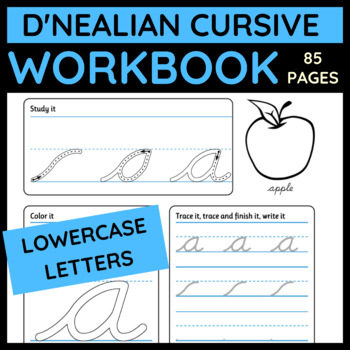Cursive Handwriting Practice Pages - Lowercase alphabet workbook - D'Nealian
- PDF
- Easel Activity
What educators are saying
Description
This workbooks provides 85 practice pages to learn the lowercase cursive alphabet, and learn to use the letters in very short words.
Correct letter shapes
Many resources for teaching cursive don't teach connections from the letters b/o/v/w the same way as they do in school. In the major handwriting curricula used at school the letters b/o/v/w end with a reversal - not with an open loop - and the connecting stroke stays pretty close to the midline throughout. I've designed my font School Cursive to match closely with the typeface that Savvas uses in their latest D'Nealian workbooks.
Entry stroke from the baseline
All words and all letters practiced individually start with an entry stroke from the baseline.
Spaced repetition
I see many resources that introduce a new letter on every page (or sometimes even two: lowercase and uppercase). I must confess that I don't have experience with teaching cursive in grade 3; in the Netherlands where I live, schools that teach cursive do so in grade 1. Nevertheless, I think one letter per page is too fast a pace even for older students. Repetition is most effective when it in spaced out in time. That's why this workbook spends at least 2 pages on every new letter. This also gives more opportunity to reinforce previously learned letters.
Scaffolding
This workbooks provides carefully thought out scaffolding that is gradually removed. First the student traces the entire letter, pattern or word. Then the students traces the beginning of a letter or word and must continue on their own to complete it. For difficult letters such as c/a/d/g/o, the position where the pattern cuts off and the student is expected to continue has been chosen carefully to support and reinforce correct letter formation. Then, the student copies letters or words - initially after tracing them, but later also without a tracing step. Once every six pages, the student is asked to transcribe from print to cursive, so that the student learns to write cursive from memory - without any example.
Letter sequence
Letters are ordered and grouped based on their graphical complexity and based on similarities. The order of letters is: i, u, n, m, r, t, e, l, j, z, y, h, k, x, s, p, c, a, d, g, q, f, v, w, b, o.
Letter formation visualized
When a new letter is introduced, its formation is explained not in a single image, but step-by-step, using multiple images. This ensures that overlapping strokes are shown clearly and unambiguously.
Connections
To bridge the gap from single letters to words, I use the intermediate step of writing double letters. Students practice connecting a letter to itself before they attempt to form words.
To prevent too much difficulty in forming words, the letters b/v/w/o are introduced at the end, and extra practice is provided using these letters in words.
How to use it this resource?
- when students encounter a new letter in the workbook:
- show them how you write the letter or watch a letter animation with them via my website: https://cursiveworkshop.com/letterformation
- let students trace a large version of the letter with their finger, and check that they do so correctly before letter them do the workbook page. If your students have tablets, you can use the included Easel activity for tracing. If not, you can use my free resource Outline letters to print out large outline letters for tracing
- only then let students complete the workbook page
- for 'trace and finish' assignments, check that the student traces from the beginning of the grey letter or word fragment (not from the end)
- for the 'color it' assignment for single letters, you can ask students to color straight segments in one color and curved segments in another color
- for the 'study it' assignment for double letters, let students trace the pattern a few times with the back of their pencil; then let them draw arrows or dots in the picture at the places where they have to reverse or (sharply) change direction
- for 'check yourself' pages, ensure that previous pages are in sight, but do allow students to look up a word (from previous pages) after they have made a first attempt at writing for memory. You can also add a (peer-)feedback step between columns.
For who?
- This resource is suitable for students who are just starting to learn cursive.
- Because of the carefully thought out letter sequence and the large amount of repetition, this resource can be used with students who haven't learned manuscript - a cursive first approach - or who have learned manuscript but aren't very good at it.
- Except during for the first introduction of a new letter, the line height is 3/8", a value that is typically used in 3rd grade in the US. I have chosen this line height because I feel that large line heights can become a burden when learning to write whole words.
- For older students, you might be able to skip parts of each practice page to get through the workbook more quickly.






